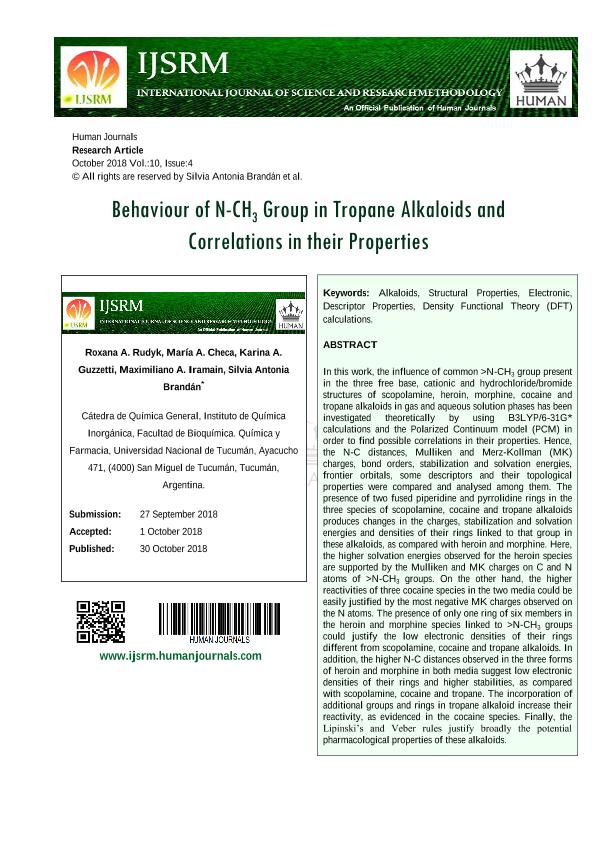Mostrar el registro sencillo del ítem
dc.contributor.author
Rudyk, Roxana Amelia

dc.contributor.author
Checa, Maria Alejandra

dc.contributor.author
Guzetti, Karina
dc.contributor.author
Iramain, Maximiliano Alberto

dc.contributor.author
Brandan, Silvia Antonia

dc.date.available
2022-06-16T15:01:11Z
dc.date.issued
2018-10
dc.identifier.citation
Rudyk, Roxana Amelia; Checa, Maria Alejandra; Guzetti, Karina; Iramain, Maximiliano Alberto; Brandan, Silvia Antonia; Behaviour of N-CH3 Group in Tropane Alkaloids and Correlations in their Properties; Paripex; Indian Journal of Research; 10; 4; 10-2018; 70-97
dc.identifier.issn
2250-1991
dc.identifier.uri
http://hdl.handle.net/11336/159947
dc.description.abstract
In this work, the influence of common >N-CH3 group present in the three free base, cationic and hydrochloride/bromide structures of scopolamine, heroin, morphine, cocaine and tropane alkaloids in gas and aqueous solution phases has been investigated theoretically by using B3LYP/6-31G* calculations and the Polarized Continuum model (PCM) in order to find possible correlations in their properties. Hence, the N-C distances, Mulliken and Merz-Kollman (MK) charges, bond orders, stabilization and solvation energies, frontier orbitals, some descriptors and their topological properties were compared and analysed among them. The presence of two fused piperidine and pyrrolidine rings in the three species of scopolamine, cocaine and tropane alkaloids produces changes in the charges, stabilization and solvation energies and densities of their rings linked to that group in these alkaloids, as compared with heroin and morphine. Here, the higher solvation energies observed for the heroin species are supported by the Mulliken and MK charges on C and N atoms of >N-CH3 groups. On the other hand, the higher reactivities of three cocaine species in the two media could be easily justified by the most negative MK charges observed on the N atoms. The presence of only one ring of six members in the heroin and morphine species linked to >N-CH3 groups could justify the low electronic densities of their rings different from scopolamine, cocaine and tropane alkaloids. In addition, the higher N-C distances observed in the three forms of heroin and morphine in both media suggest low electronic densities of their rings and higher stabilities, as compared with scopolamine, cocaine and tropane. The incorporation of additional groups and rings in tropane alkaloid increase their reactivity, as evidenced in the cocaine species. Finally, the Lipinski’s and Veber rules justify broadly the potential pharmacological properties of these alkaloids
dc.format
application/pdf
dc.language.iso
eng
dc.publisher
Paripex
dc.rights
info:eu-repo/semantics/openAccess
dc.rights.uri
https://creativecommons.org/licenses/by-nc-sa/2.5/ar/
dc.subject
ALKALOIDS
dc.subject
STRUCTURAL PROPERTIES
dc.subject
DESCRIPTORS
dc.subject
DFT CALCULATIONS
dc.subject.classification
Química Orgánica

dc.subject.classification
Ciencias Químicas

dc.subject.classification
CIENCIAS NATURALES Y EXACTAS

dc.title
Behaviour of N-CH3 Group in Tropane Alkaloids and Correlations in their Properties
dc.type
info:eu-repo/semantics/article
dc.type
info:ar-repo/semantics/artículo
dc.type
info:eu-repo/semantics/publishedVersion
dc.date.updated
2022-06-13T18:44:19Z
dc.journal.volume
10
dc.journal.number
4
dc.journal.pagination
70-97
dc.journal.pais
India

dc.journal.ciudad
Punjab
dc.description.fil
Fil: Rudyk, Roxana Amelia. Universidad Nacional de Tucuman. Facultad de Bioquimica, Quimica y Farmacia. Instituto de Quimica Inorganica. Cátedra de Química General.; Argentina
dc.description.fil
Fil: Checa, Maria Alejandra. Universidad Nacional de Tucuman. Facultad de Bioquimica, Quimica y Farmacia. Instituto de Quimica Inorganica. Cátedra de Química General.; Argentina
dc.description.fil
Fil: Guzetti, Karina. Universidad Nacional de Tucuman. Facultad de Bioquimica, Quimica y Farmacia. Instituto de Quimica Inorganica. Cátedra de Química General.; Argentina
dc.description.fil
Fil: Iramain, Maximiliano Alberto. Universidad Nacional de Tucuman. Facultad de Bioquimica, Quimica y Farmacia. Instituto de Quimica Inorganica. Cátedra de Química General.; Argentina. Consejo Nacional de Investigaciones Científicas y Técnicas. Centro Científico Tecnológico Conicet - Tucumán; Argentina
dc.description.fil
Fil: Brandan, Silvia Antonia. Universidad Nacional de Tucuman. Facultad de Bioquimica, Quimica y Farmacia. Instituto de Quimica Inorganica. Cátedra de Química General.; Argentina
dc.journal.title
Indian Journal of Research
dc.relation.alternativeid
info:eu-repo/semantics/altIdentifier/url/http://ijsrm.humanjournals.com/wp-content/uploads/2018/11/6.Roxana-A.-Rudyk-Mar%C3%ADa-A.-Checa-Karina-A.Guzzetti-Maximiliano-A.-Iramain-Silvia-Antonia-Brand%C3%A1n.pdf
Archivos asociados
